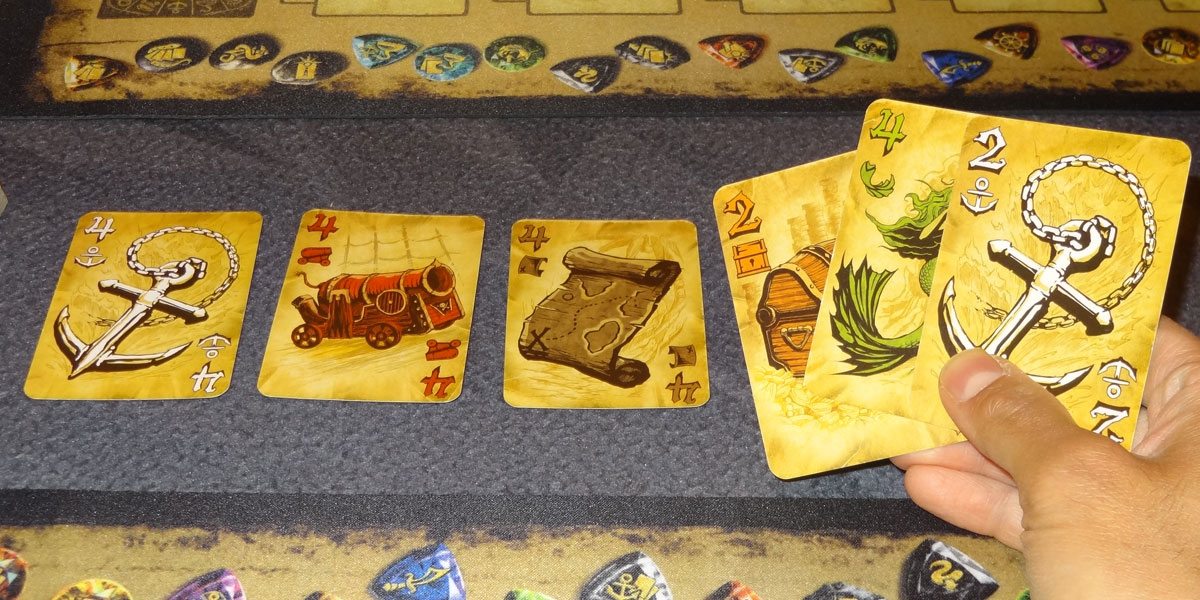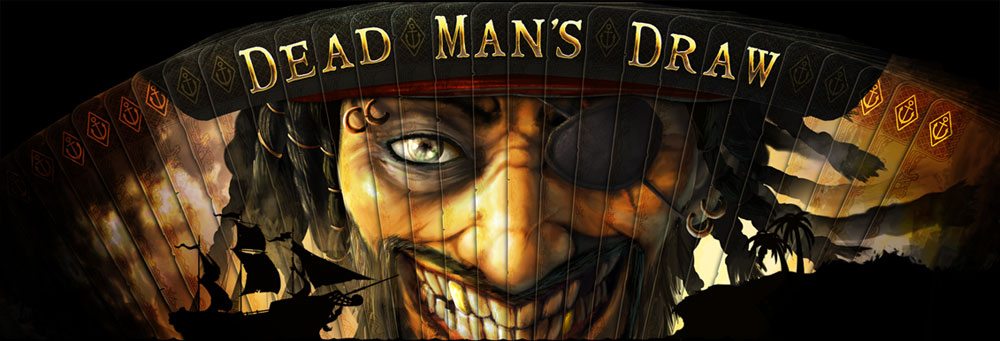In “Reaping the Rewards,” I take a look at a crowdfunded project in its final form. Dead Man’s Draw is a fantastic press-your-luck card game with a pirate theme. The journey from idea to reality took a long time and had a few missteps. Was it worth the wait?
Here’s the quick story: the origins of Dead Man’s Draw actually stretch back to 2007, when a fan-made mod of Civilization IV included a mini-game called Somnium. A few years later, and Derek Paxton, the creator of that mod, was now head of Stardock Entertainment. Stardock’s first iOS game was Dead Man’s Draw, built on the concept of Somnium but expanded quite a bit. In 2013, after the app was released, Stardock ran a Kickstarter campaign to fund the printing of a physical version of the game. Unfortunately, the campaign didn’t reach its goal, and for some time fans thought the game would never get made–Stardock released the print and play files and said they were done. Then, last year, Mayday Games got the rights to the game and ran a successful Kickstarter campaign (running demos at Gen Con last year). The game was finally finished and sent to backers earlier this year, and made its true Gen Con debut this year.
At a glance: Dead Man’s Draw is for 2 to 4 players, ages 13 and up, and takes 10-15 minutes to play. Despite the age rating from the publisher, it’s actually fairly easy to learn the rules and you can play with much younger kids, too. It retails for $20 and is available now.
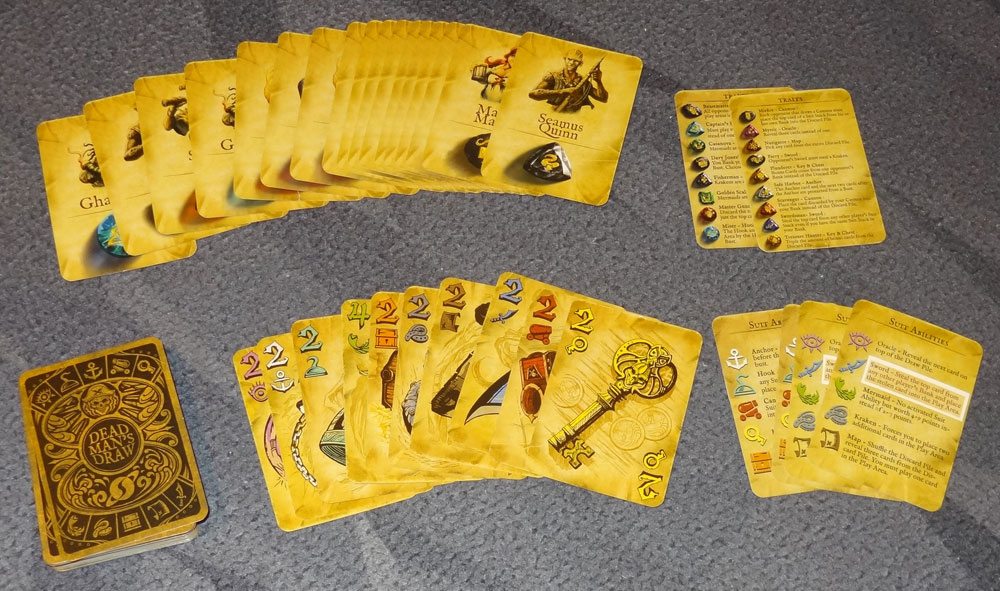
Components:
- 60 Loot cards (6 each in 10 suits)
- 17 Trait cards
- 4 Suit summary cards
- 2 Trait summary cards
The Loot card graphics are exactly the same as those from the app, with the number and an icon in the top left and bottom right corners of the cards, and a large illustration in the center. The Trait cards feature a pirate portrait at top, the pirate’s name in the center, and a gemstone representing the power below.
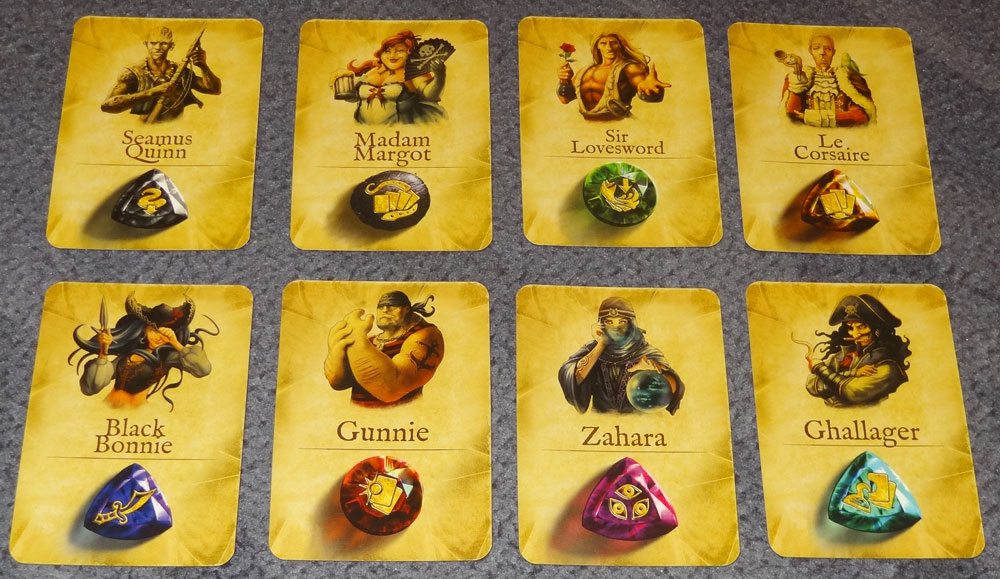
It’s not entirely clear to me why the cards do not have the Trait abilities printed directly on them–instead, you refer to the Trait summary card (or the rulebook) to find out what the traits do. For the 10 suits in the Loot deck, you do learn pretty easily, but there are 17 different trait icons and they’re not as intuitive.
On the Suit summary cards, the “Sword” ability was printed incorrectly, and there were small stickers given to place on the cards. Unfortunately, the replacement stickers are still not totally correct, so be sure to check the rulebook for details.
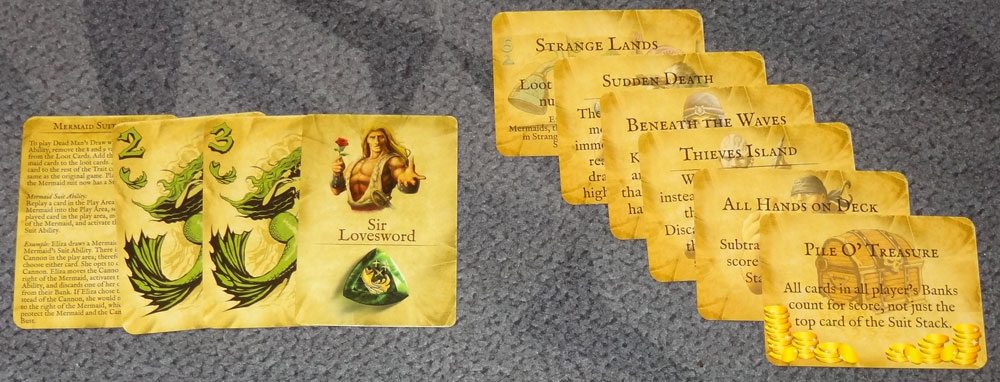
The Kickstarter version also included 1 additional trait card, 2 Mermaid cards, and 6 alternate rules cards. The Kickstarter version also has a variant box cover. I did notice that the Kickstarter bonus cards don’t quite match the originals in color and the rounded corners, so you can tell them apart if you’re paying attention.

The box is bigger than necessary for the cards–it could have been a side-by-side at half the thickness–but it’s still a fairly compact box overall.
All of the cards have a linen finish and are generally nice, but it does seem that the quality control is lacking in a few places.
How to Play
The object of the game is to have the highest score when the draw pile runs out–your score is the total of the highest card from each suit in your bank.
To set up, first pull out the lowest card of each suit to form the discard pile. (Most suits go from 2 to 7, but the Mermaid suit goes from 4 to 9). I sometimes forget this step, but it’s important to have some cards in the discard pile when the game begins.
If you’re using the Traits (more on that below), you’ll shuffle the Trait cards and give two to each player. Everyone chooses one to keep and one to discard, and then reveals them simultaneously.

On your turn, you may flip cards from the draw pile one at a time. If you draw a suit that you’ve already played this turn, then you bust and all of your cards are discarded (and that card’s ability is not played). Otherwise, you place the card into the play area and activate its ability if possible. You may choose to stop at any time before you bust, in which case you take all the cards you’ve played this turn and add them to your bank (sorted by suits, with the highest card on top).
Although you only score for the top card of each suit, it’s still a good idea to collect multiple cards in a suit because that protects your score somewhat if a card gets stolen or destroyed by an opponent.
Each suit has its own ability, which must be activated if possible when the card is played, even if it causes you to bust.
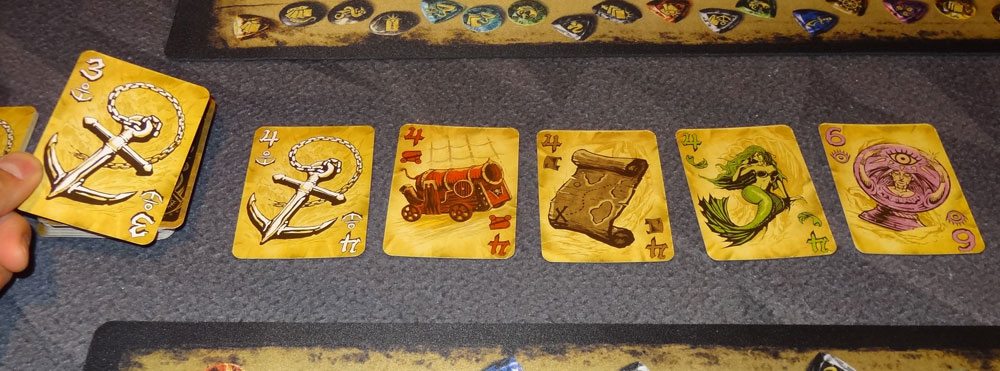
Oracle (crystal ball): Reveal the next card in the draw pile.
Cannon: Select the top card in a stack from another opponent’s bank and discard it.
Hook: Play the top card from a stack from your own bank.
Sword: Steal the top card in a stack from an opponent and play it. You must steal a suit that you do not have in your bank yet.
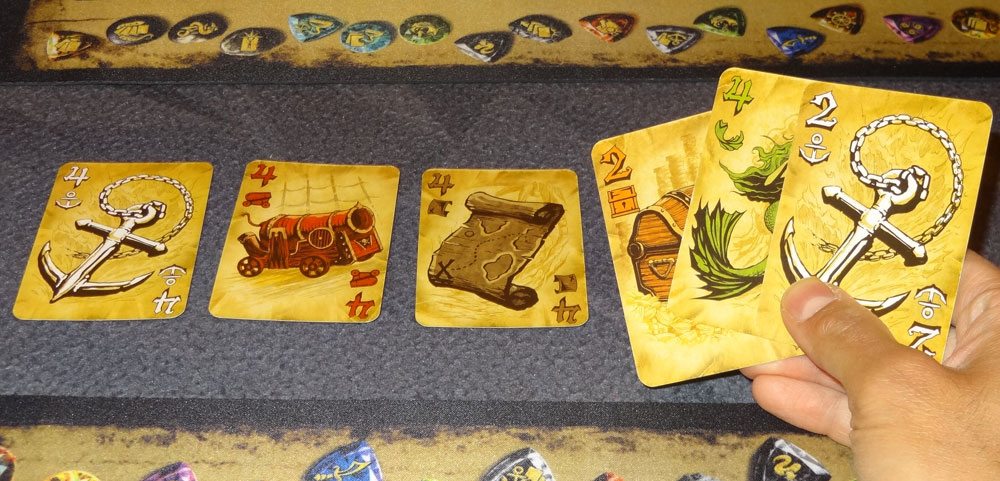
Map: Shuffle the discard pile and reveal three cards. Play one, discard the others.
Anchor: If you bust on this turn, you still get to bank all the cards played before the Anchor (but not the Anchor itself).
Kraken: You must play two more cards before you can end your turn. (If the first of these has an ability that causes you to play another card, that card counts as the second play.)
Mermaid: No special ability; Mermaids simply have higher point values.

Key and Chest: If you have both a Key and a Chest in the play area when you collect your cards, you get to take bonus cards from the discard pile (equal to the number you collected).
The Trait cards add special powers for the players, and make the game asymmetrical. Most of the powers affect a single suit, either for yourself or for all your opponents, but there are some exceptions too. Mystic lets you reveal three cards instead of one with the Oracle. Fisherman lets you automatically bank Kraken cards when they’re drawn, so they don’t give you a penalty. Misfire forces your opponents to use Cannons against themselves. Like the suit abilities, Trait abilities must be used when possible, even when it is to your own disadvantage.
The game ends when the last card of the draw pile has been played. Total up the highest card from each suit in your bank for your score; highest score wins. Ties to go the player with the most total cards banked.
The Verdict
I grabbed the iOS version of Dead Man’s Draw during the first Kickstarter campaign and really hoped the project would succeed, because it was a game I wanted to play with my friends and family. I was sorely disappointed that it failed to fund and was thrilled that Mayday Games picked up the license for it. Mayday Games gave me a copy at Gen Con (along with two of the playmats)–we played a few times at the con, and then I took it on my family vacation where I played it with my dad, brother, and nieces and nephews and kids.
It’s an easy one to learn (especially if you leave out the Trait cards the first time around) and even less experienced gamers pick up the rules pretty quickly. I like press-your-luck games even though by definition they’re heavily dependent on luck. I do feel that Dead Man’s Draw has some twists that add at least a little more choice than “keep going or stop.” In particular, the powers of the cards let you make additional choices that might allow for an interesting chain of cards. Since the Sword and Cannon affect other players’ banked cards, you can decrease somebody’s score even if you bust.
In many press-your-luck games, you don’t directly affect other players–it’s more of a race to see how far you can push without busting, while everyone else does the same. Not so with Dead Man’s Draw: even your banked cards aren’t totally safe.

The playmats are pretty but aren’t totally necessary–they just store your banked cards, which means that each player needs one. I’m not really a playmat sort of guy usually, but it is a nice mat. If I’m playing with two players I’ll probably break these out, but otherwise the table is fine for me.
All in all, I’m very pleased with Dead Man’s Draw and it’s definitely one that will hit the table a lot when I need a quick filler game or something that I can play with both kids and adults together. It won’t scratch the heavy strategy itch, but it’s got a nice bit of depth to it for what it is. Despite some hiccups with the production value, it’s a really fun game to play and the problems didn’t bother me much. Once you’ve learned the rules you don’t need the misprinted summary cards anyway.
Dead Man’s Draw is available online or check with your local game store. Definitely worth the $20 if you’re looking for a quick, fun game.
